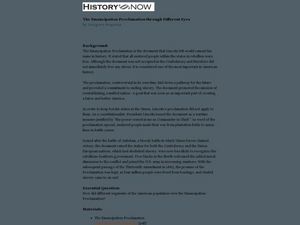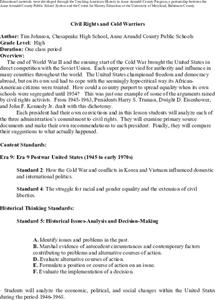Curated OER
Who Was Contraband?
Learners examine the role of African-Americans in the Civil War. Using primary sources, they analyze the material and formulate their own opinions about the past. They write journal entries to share their opinions on photographs from the...
Curated OER
Map the Civil War
Students explore the Civil War through original maps. In this mapping activity, students calculate distance and show it on an original map. Students examine the type of landscape and its landmarks and draw symbols on the map.
Curated OER
The Gettysburg Address
Who was Abraham Lincoln, and what is the Gettysburg Address? Sixth graders participate in a seminar where they read and analyze the Gettysburg Address and its importance. The role of Abraham Lincoln during the Civil War is also...
Curated OER
Lincoln, Emancipation, and the Constitution
Students determine how President Lincoln promoted emancipation. In this slavery lesson, students examine primary documents, including the U.S. Constitution, to reconstruct Lincoln's attempts to end slavery and deliver the Emancipation...
Curated OER
A Hoosier Perspective on the March to the Sea: The Diary of William Miller
Eighth graders take a closer look at Sherman's March to the Sea. In this American Civil War lesson, 8th graders analyze the diary entries of William Miller. Discussion questions are included with the entries. Students create illustrated...
Curated OER
Hoosier Soldiers at Vicksburg
Eighth graders examine the role of Indiana soldiers at the Battle of Vicksburg. In this American Civil War lesson plan, 8th graders listen to a lecture about the involvement of Indiana soldiers in the battle and then analyze letters...
Curated OER
1864-1865: Bringing the War to an End
An interesting lesson plan explains the last battles of the war and the terms of the Articles of Surrender. It also analyzes the election of 1864 with copies of the Baltimore and Chicago platforms. To conclude the lesson, academics...
Curated OER
Abraham Lincoln: The Face of War
Students compare life masks and photos of Abraham Lincoln that were made before and at the end of the Civil War. In this "Faces of War" lesson, students analyze images of Lincoln in a historical context and create a timeline of event.
Curated OER
Political and Social Origins of the Civil War
Students examine the difference in politics in the North and South during the Civil War. Using that information, they discuss how politics and ideologies led to the war. They explain the causes and effects of the war and evaluate the...
Curated OER
The Civil War in Art and Literature
Students examine art related to the Civil War. They participate in activities that allow them to write poetry and drawings. They create their own journal and collect their work in a binder.
PBS
Think Like a Historian: A Viewing Guide
Calling all junior detectives! Scholars use the tools of investigation to determine the causes and impacts of the American Civil War. Using viewing guides, videos, group research, and written resources, they discover what it takes to...
Curated OER
Freed Slaves
Students are given the identify of a newly freed slave at the end of the Civil War. Students participate in a discussion to explore some of the difficulties and decision making freed slaves had to consider. Students present their...
American Battlefield Trust
John Brown
How did the raid on Harper's Ferry contribute to the start of the Civil War? Curated for high school historians, the activity explains John Brown's contribution to the start of the Civil War by using violence to demand an end to slavery....
Curated OER
The Emancipation Proclamation Through Different Eyes
Students examine how various segments of the American population viewed the Emancipation Proclamation. They read the Emancipation Proclamation, analyze key terms and statements in the document, and participate in a debate.
Carolina K-12
African Americans in the United States Congress During Reconstruction
The Civil Rights Act of 1866, which granted citizenship to all males in the U.S., resulted in the first African Americans to be elected to Congress. Class members research 11 of these men, the challenges they faced, and craft...
NET Foundation for Television
1850-1874 The Kansas-Nebraska Act
How the Kansas-Nebraska Act created Bleeding Kansas is complicated—until scholars research and examine documents from the time. After completing activities that include mapping, photo, document analysis, and discussion, learners...
Curated OER
Freedmen's Bureau
Students examine the African American experience after they received their freedom after the Civil War. They complete a Mind Map, read and analyze a poem, and write a paragraph using key vocabulary words. They analyze the impact of the...
PBS
African American History: Climbing the Wall
Imagine the challenge of trying to trace your family genealogy if no records were kept of births and deaths. Where would you look for information? What types of documents could provide you with the information you seek? History...
US House of Representatives
“The Fifteenth Amendment in Flesh and Blood,” The Symbolic Generation of Black Americans in Congress, 1870–1887
The reading of a contextual essay launches a study of Black Americans who served in Congress from 1870 through 1887. Young historians identify the African Americans who served during this period, investigate the ways they won national...
Center for History Education
Civil Rights and Cold Warriors
Three presidents, three views on civil rights. Scholars compare the administrations of President Truman, Eisenhower, and Kennedy to understand how each addressed the issue of civil rights. The lesson uses primary sources and graphic...
Curated OER
After Reconstruction: Problems of African Americans
Students describe issues or problems facing African Americans following Reconstruction. They explain possible solutions to these problems suggested in the sources you find, and cite arguments for and against these solutions.
National Park Service
Lesson 6: Researching Contemporary Slavery
While many believe slavery ended after the American Civil War, it continues today in various forms. Using a WebQuest research project, class members investigate how the institution of slavery lives on in the modern world. Activities also...
Curated OER
Southern Society during the Civil War: Black Society
Students research and discuss the societal changes during the Civil War as it relates to various parts of southern society. For this southern society during the civil war lesson, students examine what life was like for slaves during the...
Curated OER
Hoosier Soldiers and the Emancipation Proclamation
Eighth graders examine the impact of Lincoln's Emancipation Proclamation through the eyes of Indiana soldiers. In this American Civil War lesson plan, 8th graders read the proclamation and then students write essays that included letters...

























